COVID-19 pandemic in Arizona facts for kids
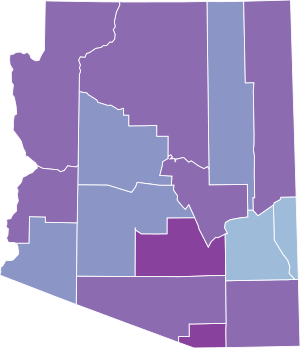
Map of the outbreak in Arizona by confirmed new infections per 100,000 people over 14 days (last updated March 2021)
1,000+ 500–1,000 200–500 100–200 50–100 20–50 10–20 0–10 No confirmed new cases or no/bad data |
|
|
Map of the outbreak in Arizona by confirmed total infections per 100,000 people (last updated March 2021)
10,000+ 3,000–10,000 1,000–3,000 300–1,000 100–300 30–100 0–30 No confirmed infected or no data |
|
| Disease | COVID-19 |
|---|---|
| Virus strain | SARS-CoV-2 |
| Location | Arizona, U.S. |
| First case | Tempe |
| Arrival date | January 26, 2020 |
| Origin | Wuhan, Hubei, China |
| Confirmed cases | 2,196,429 |
|
Deaths
|
30,768 |
Quick facts for kids Official website |
|
| https://www.azdhs.gov/preparedness/epidemiology-disease-control/infectious-disease-epidemiology/index.php#novel-coronavirus-home | |
The COVID-19 pandemic was a worldwide health crisis. It reached the U.S. state of Arizona in January 2020. By June 3, 2021, Arizona had reported over 882,000 cases of COVID-19. Sadly, more than 17,000 people had died from the virus. This meant about 12% of Arizona's population had been diagnosed with COVID-19.
After Governor Ducey ended Arizona's statewide lockdown on May 15, 2020, new cases of COVID-19 quickly increased. The number of daily cases jumped from about 377 to 3,249 by mid-July. On June 17, Governor Ducey asked people to wear masks. He also let cities and counties make their own mask rules. Most major cities in Arizona then required masks. Cases and deaths kept rising through July 2020.
In August, the number of new cases dropped a lot. This lower rate continued through October 2020. But in November, a second big wave of COVID-19 began. It reached new record numbers in early January 2021. On January 3, Arizona had 17,236 new cases in one day. On January 12, 335 deaths were reported. The COVID-19 pandemic in the Navajo Nation was especially difficult. This was due to health challenges and limited access to services.
By June 3, 2021, Arizona had given out almost 6 million COVID-19 vaccine doses. Over 2.4 million people were fully vaccinated. This was about 34% of the state's population.
Timeline of COVID-19 in Arizona
First Cases and Early Actions in 2020
The first confirmed case of COVID-19 in Arizona was announced on January 26, 2020. It was a 20-year-old student from Arizona State University (ASU). The student had traveled from Wuhan, China, where the outbreak began. After recovering, the student was released from isolation. This was the fifth reported COVID-19 case in the United States.
|
|||||||||||||||||||||||||||||||||||||||||||||||||||||||||||||||||||||||||||||||||||||||||||||||||||||||||||||||||||||||||||||||||||||
On March 6, a healthcare worker in Pinal County was diagnosed. This was the first case where the source of infection was unknown. This is called "community spread."
On March 7, a man in Phoenix who had traveled to Paris tested positive. He worked at a nightclub in Scottsdale. The nightclub was professionally cleaned.
On March 11, Jonathan Nez, president of the Navajo Nation, declared a state of emergency. This was to prepare for the COVID-19 crisis.
Arizona Governor Doug Ducey declared a public health emergency on March 12. At this time, there were nine confirmed cases in Arizona.
Schools and Closures in March 2020
Arizona universities started moving classes online in March. Arizona State University, the University of Arizona, and Northern Arizona University all made this change. The University of Arizona later canceled its in-person graduation ceremony.
On March 17, the first COVID-19 case was confirmed in the Navajo Nation. More rules were put in place to limit visitors to tribal lands.
Tucson mayor Regina Romero declared a local emergency on March 17. Many businesses like bars and theaters were ordered to close. Restaurants could only offer takeout. Other cities in the Phoenix area also made similar rules.
Governor Ducey announced on March 19 that restaurants would have limited service. Bars, theaters, and gyms in certain counties would close. He also asked the Arizona National Guard to help restock grocery stores. This was to protect food supplies. The governor also extended driver's license expiration dates. This helped older residents avoid waiting in line. On March 20, the first death from COVID-19 in Arizona was reported. It was a man in his 50s from Maricopa County.
On March 30, Governor Ducey issued a statewide stay-at-home order. This meant Arizonans could only leave their homes for essential things like food or medicine. The Arizona National Guard also set up a medical station in Chinle, Arizona, to help the Navajo Nation.
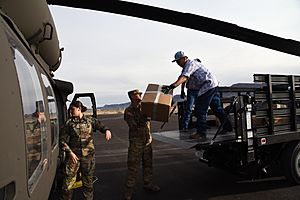
Reopening and Surges in Spring/Summer 2020
On April 22, a group from Arizona State University predicted infections would peak in mid-May. This led the Arizona Department of Health Services (AZDHS) to pause their data work.
On April 29, Governor Ducey announced a partial reopening of businesses starting May 4. The stay-at-home order was extended until May 15. Hair salons and barbershops could reopen on May 8. Restaurants could open dining rooms on May 11.
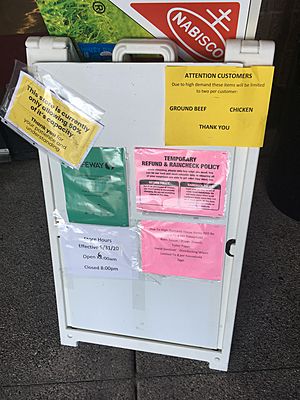
On May 6, researchers at Arizona State University were told to stop their COVID-19 modeling work. Their model had suggested not reopening before the end of May. The state decided to use a different model for predictions.
On May 12, Governor Ducey announced the stay-at-home order would end on May 15. Gyms and pools could reopen on May 13.
On May 15, the statewide lockdown ended. There were over 13,000 confirmed cases and 651 deaths. Businesses were allowed to reopen with safety measures. Sports leagues could also restart without fans.
After the lockdown ended, local governments could not make their own stricter COVID-19 rules. This meant they couldn't require masks. However, the governor changed this rule in June.
By May 31, two weeks after the order ended, the percentage of positive COVID-19 tests had risen to 12%.
Rising Cases in June 2020
Two weeks after the stay-at-home order ended, Arizona reported a record number of hospitalizations. On June 1, there were 1,009 hospitalizations.
By June 8, cases and deaths continued to rise. The Arizona Department of Health Services asked hospitals to prepare emergency plans.
On June 10, Governor Ducey held a press conference. He focused on hospitals having enough space for patients. He said the plan was to focus on public health education.
On June 12, the President of Arizona State University made face coverings mandatory on campus.
On June 17, Governor Ducey allowed local governments to set mask rules. Many cities and counties then required face coverings. Hospitals were very busy, at 85% capacity.
On June 23, former President Donald Trump held a rally in Phoenix. Most people there did not wear masks.
On June 29, Governor Ducey ordered bars, movie theaters, and gyms to close again. This was a partial reversal of the state's reopening. Arizona also activated its Crisis Standards of Care Plan. This plan helps hospitals manage resources during a crisis.
Summer Challenges in July 2020
On July 1, 2020, a school called Canyon State Academy reported 23 students and 8 staff members tested positive.
By July 3, over 90% of hospital intensive care unit (ICU) beds were full statewide. The federal government sent medical professionals to help.
On July 9, Governor Doug Ducey ordered restaurants to operate at 50% capacity. At this time, the death toll reached 2,000. Total cases passed 112,000.
On July 16, the governor extended a ban on residential evictions. This helped people who couldn't pay rent.
On July 23, the governor extended the closure of certain businesses for two more weeks. He also banned gatherings of more than 50 people.
Fall and Winter Surges in 2020
On August 27, the University of Arizona found two asymptomatic cases through wastewater testing at a dorm.
In October 2020, some schools in Pinal and Maricopa counties closed due to outbreaks.
On October 19, a campaign rally near Tucson drew over 2,000 supporters. Few wore masks.
On October 22, during a presidential debate, it was claimed that Arizona's spike had "gone." However, local newspapers reported that the virus was spreading quickly again. Cases, hospitalizations, and positive test rates were all increasing.
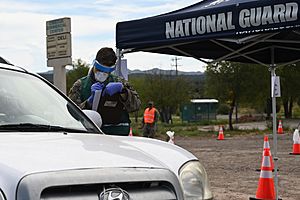
In November 2020, a doctor raised concerns about a lack of ICU beds in Arizona.
On November 27, the University of Arizona COVID-19 Modelling Team warned of a potential "catastrophe." They suggested shelter-in-place orders and mask mandates.
On December 7, the Arizona State Legislature closed for a week. This happened after a lawyer who tested positive for COVID-19 testified without a mask.
By December 10, Arizona had the highest rate of virus spread in the nation. The governor decided not to close businesses. His team believed most spread came from family gatherings.
Arizona faced a shortage of health workers to give out COVID-19 vaccines. By December 31, only about 20% of available doses had been used statewide.
Vaccination Efforts in 2021
On January 11, 2021, a 24/7 COVID-19 vaccination site opened at State Farm Stadium in Glendale.
On January 19, the Director of AzDHS, Dr. Christ, stated that Arizona was doing well with vaccine distribution. She noted that thousands of appointments were still available.
In early March 2021, Gila County opened vaccinations to all residents aged 18 or older.
Impact of the Pandemic
Economy and Jobs
In April 2020, Arizona received $1.86 billion in federal relief funds. Much of this money went to cities and businesses. The state unemployment rate reached 12.6%. This meant 276,300 jobs were lost. Most job losses were in tourism and hospitality.
In May 2020, state officials predicted a $1.1 billion budget shortfall. This was due to lower tax income and higher healthcare costs. Over half a million Arizonans filed for unemployment benefits. Some people had trouble getting extra unemployment funds.
On June 1, 2020, the Arizona Department of Economic Security announced it received over $24 million for relief. These funds would help low-income people with bills and housing. By that week, unemployment claims rose to over 620,000.
Schools and Learning
After COVID-19 hit, schools in Arizona moved to online learning. On March 30, Governor Ducey closed all schools statewide. He required them to offer alternate ways for students to learn.
After the lockdown ended, Governor Ducey announced schools would reopen for in-person classes in the fall. The AZDHS director described plans to reduce class sizes. They also planned for cleaning and flexibility for high-risk students and staff.
On June 1, 2020, the Arizona Department of Education released guidelines for reopening schools. These included masks for staff and older students. They also covered staying home when sick and frequent cleaning. Ducey later delayed in-person school until August 17. On July 24, he said schools wouldn't reopen until public health goals were met. These goals were set by AZDHS on August 6. They included low case numbers, low positive test rates, and low hospital visits.
Despite not meeting the goals, some school districts voted to resume in-person classes. This led to some teachers staging a "sick out."
Higher Education Changes
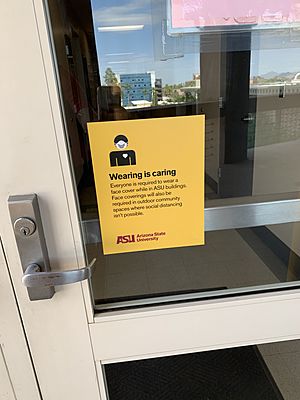
By March 12, many universities moved courses online. This included all three state universities. By late April, all three planned to resume in-person classes in the fall. They planned safety measures like testing and classroom changes. In June, all state universities required masks on campus.
Many universities also cut staff salaries. This was due to financial difficulties from the pandemic.
Sports and Events
Major League Baseball (MLB) canceled spring training on March 12. This affected ten venues in Phoenix. It also impacted many jobs. On March 16, MLB postponed its regular season indefinitely. This affected all teams that train in Arizona. The Cactus League brings over 1 million visitors to Arizona each year. It generates over $600 million for the Phoenix economy. MLB later discussed playing the 2020 season entirely in Phoenix. Games would be played in empty stadiums.
In the National Basketball Association, the season was suspended on March 12. This affected the Phoenix Suns. Suns player Devin Booker pledged $100,000 to help local charities. These charities assisted seniors, families, and children.
The National Hockey League also suspended its season indefinitely. This affected the Arizona Coyotes.
NASCAR held its last race with a crowd in Avondale on March 7–8. This was before the season was put on hold.
Statistics
Demographics of Cases
Source: Data from the Arizona Department of Health Services, as of July 27, 2022.
Progression Charts
See also
 In Spanish: Pandemia de COVID-19 en Arizona para niños
In Spanish: Pandemia de COVID-19 en Arizona para niños

